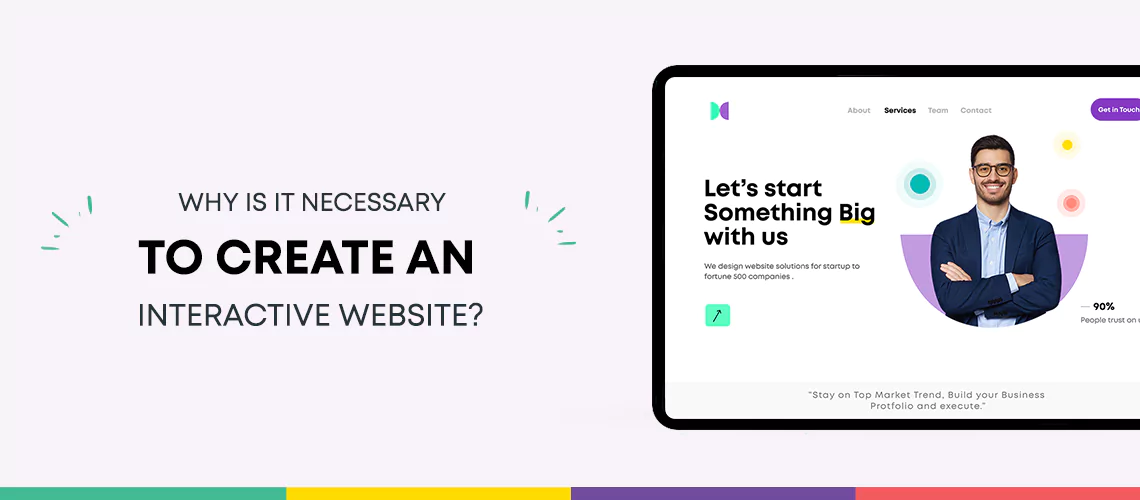Interactivity should be invisible to users, despite the fact that it is an important component of the user experience. In general, your website’s interactive design is successful only when your consumers are unaware of the painstakingly planned interactive procedures that guide their activities.
Designing something so crucial but illusive is, as you can think, a difficult task. I explain the techniques and goals of an interactive designer, as well as why you should hire LeadingEdgeZone for your next web design project.
Interactive Design vs. User Experience Design
Interactive Design focuses on your user’s direct and active participation with your website, such as clicking, dragging, tapping, typing etc. Meanwhile, User Experience (UX) design takes a broader view of interaction, considering even times of passive use, such as reading a sentence on your website’s page, to constitute interaction.
As a result, interactive website design is a type of UX website design that focuses on encouraging and enabling user active involvement moments. Some UX designers prefer to focus on this element of UX design and polish their talents in implementing interaction patterns to perfection. To assure the quality of interactive design, we usually engage such dedicated professionals at LeadingEdgeZone on highly interactive web design projects.
Interactive design elements
Every interaction moment is broken down into 5 pieces by interactive design techniques. The majority of these components are applicable to all forms of interactions, however some are optional at times. The role of the UX Specialist is to determine what pieces are required for each interaction instance in order for it to seem natural and smooth.
Here’s the list of all 5 elements:
- Text – A word or a symbol that denotes the possibility of contact and emphasizes the expected outcomes rather than the activity itself. Consider a ‘Play’ line or a triangular symbol that conveys the same meaning.
- Visual Form – Some interactive features, like as buttons or forms, should have clearly visible margins that define the interaction zone. You don’t want your potential buyer to have to search for the input zone while filling out a shipping address for their order.
- Medium / Platform – Because various interactions necessitate different actions on different devices, an interactive design expert should make sure that the interaction-inducing behaviors are consistent across all platforms.
- Time – Specific interactions take time to process input data, and your website should constantly bring visitors up to date on the status of that data processing. Otherwise, consumers may perceive the website to be unresponsive and abandon it without waiting for a response.
- Feedback – Your website should clearly display the consequence of each interaction to offer a user a sense of success. For example, when a person shares an article from your website on social media, display the ‘Success!’ message.
The functions of each of these parts appear to be clear, and selecting the ones that are required to put together a seamless interaction flow looks to be a simple operation. Even yet, I’m sure you’ve come across plenty of site designs with broken interaction flows that have perplexed you or made you quit, just as I have. The goal of expert interactive website design is to prevent any potential hazards to your organization by avoiding user misunderstanding.
Merits of quality interactive design
The negative implications of poor interactive website design can be devastating, but the positive results of good interactive website design can be equally as remarkable. Let’s take a look at a couple of them.
Reduced support expenses and improved service quality
Users will have less reasons to contact your help if they don’t have any problems interacting with your website, resulting in lower support charges. As a result, by ensuring that each interaction instance on your website is correctly built, you may protect your support specialists from such minor errors, allowing them to focus on more complicated and unusual instances, so improving support quality.
Decreased bounce rate
Visitors who encounter a perplexing interaction are more likely to bounce and never return rather than seek assistance. An interactive design that has been professionally planned and tested reduces the likelihood of consumers becoming frustrated with your website and lowers the bounce rate.
Higher revenue
Whether your website’s money is generated from clicks or sales, it is inextricably linked to the engagement processes. Allowing consumers to have a positive experience when connecting with your website encourages them to participate more frequently, resulting in increased income.
Increased loyalty
There’s a qualifier to what I mentioned at the outset about effective interaction design being natural enough not to draw attention to itself. If you draw your users’ attention to interactive aspects by infusing them with a sense of freshness and creativity, you may stand out from the crowd and leave a lasting impression on your visitors, bolstering their desire to do business with you.
Profit from your consumers’ convenience.
A client connecting with your company is a user who interacts with your website. Just as you wouldn’t want your company communication to look muddled and ineffective, you shouldn’t let your website’s interaction design be defined by these characteristics. Whether you want to avoid interactive design difficulties in the future or correct them on an existing website, LeadingEdgeZone can help.
